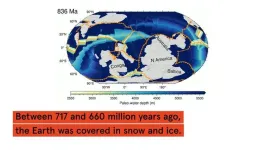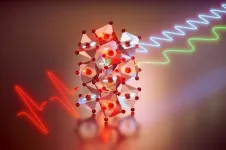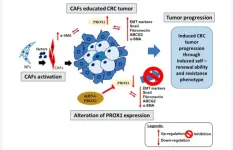(Press-News.org) Australian geologists have used plate tectonic modelling to determine what most likely caused an extreme ice-age climate in Earth’s history, more than 700 million years ago.
The study, published in Geology, helps our understanding of the functioning of the Earth's built-in thermostat that prevents the Earth from getting stuck in overheating mode. It also shows how sensitive global climate is to atmospheric carbon concentration.
“Imagine the Earth almost completely frozen over,” said the study’s lead author, ARC Future Fellow Dr Adriana Dutkiewicz. “That’s just what happened about 700 million years ago; the planet was blanketed in ice from poles to equator and temperatures plunged. However, just what caused this has been an open question.
“We now think we have cracked the mystery: historically low volcanic carbon dioxide emissions, aided by weathering of a large pile of volcanic rocks in what is now Canada; a process that absorbs atmospheric carbon dioxide.”
The project was inspired by the glacial debris left by the ancient glaciation from this period that can be spectacularly observed in the Flinders Ranges in South Australia.
A recent geological field trip to the Ranges, led by co-author Professor Alan Collins from the University of Adelaide, prompted the team to use the University of Sydney EarthByte computer models to investigate the cause and the exceptionally long duration of this ice age.
The extended ice age, also called the Sturtian glaciation after the 19th century European colonial explorer of central Australia, Charles Sturt, stretched from 717 to 660 million years ago, a period well before the dinosaurs and complex plant life on land existed.
Dr Dutkiewicz said: “Various causes have been proposed for the trigger and the end of this extreme ice age, but the most mysterious aspect is why it lasted for 57 million years – a time span hard for us humans to imagine.”
The team went back to a plate tectonic model that shows the evolution of continents and ocean basins at a time after the breakup of the ancient supercontinent Rodina. They connected it to a computer model that calculates CO2 degassing of underwater volcanoes along mid-ocean ridges – the sites where plates diverge and new ocean crust is born.
They soon realised that the start of the Sturtian ice age precisely correlates with an all-time low in volcanic CO2 emissions. In addition, the CO2 outflux remained relatively low for the entire duration of the ice age.
Dr Dutkiewicz said: “At this time, there were no multicellular animals or land plants on Earth. The greenhouse gas concentration of the atmosphere was almost entirely dictated by CO2 outgassing from volcanoes and by silicate rock weathering processes, which consume CO2.”
Co-author Professor Dietmar Müller from the University of Sydney said: "Geology ruled climate at this time. We think the Sturtian ice age kicked in due to a double whammy: a plate tectonic reorganisation brought volcanic degassing to a minimum, while simultaneously a continental volcanic province in Canada started eroding away, consuming atmospheric CO2.
“The result was that atmospheric CO2 fell to a level where glaciation kicks in – which we estimate to be below 200 parts per million, less than half today’s level.”
The team's work raises intriguing questions about Earth's long-term future. A recent theory proposed that over the next 250 million years, Earth would evolve towards Pangea Ultima, a supercontinent so hot that mammals might become extinct.
However, the Earth is also currently on a trajectory of lower volcanic CO2 emissions, as continental collisions increase and the plates slow down. So, perhaps Pangea Ultima will turn into a snowball again.
Dr Dutkiewicz said: “Whatever the future holds, it is important to note that geological climate change, of the type studied here, happens extremely slowly. According to NASA, human-induced climate change is happening at a pace 10 times faster than we have seen before.”
RESEARCH
‘Duration of Sturtian “Snowball Earth” glaciation linked to exceptionally low mid-ocean ridge outgassing’, Dutkiewicz, A. et al (Geology, 2024). DOI: 10.1130/G51669.1
DOWNLOAD video of tectonic movements and images of glacial debris at this link.
INTERVIEWS
Dr Adriana Dutkiewicz | adriana.dutkiewicz@sydney.edu.au
Professor Dietmar Müller | dietmar.muller@sydney.edu.au
MEDIA ENQUIRIES
Marcus Strom | marcus.strom@sydney.edu.au | +61 474 269 459
EARTHBYTE
This work was enabled by the GPlates plate tectonic software, developed by the EarthByte Group at the University of Sydney, which has been the basis of a slew of discoveries over the past decade, contributing significant knowledge to how geology is a central long-term driver of climate and biodiversity. GPlates development is supported by the AuScope National Collaborative Research Infrastructure System (NCRIS) program.
DECLARATION
The authors declare no competing interests. Research was in part funded by the Australian Research Council.
END
What turned Earth into a giant snowball 700m years ago? Scientists now have an answer
All-time low volcanic carbon emissions triggered a 57-million-year-long global ice age
2024-02-08
ELSE PRESS RELEASES FROM THIS DATE:
Researchers estimate survival chances during CPR for cardiac arrest
2024-02-08
A person’s chance of surviving while receiving cardiopulmonary resuscitation (CPR) for cardiac arrest in hospital declines rapidly from 22% after one minute to less than 1% after 39 minutes, finds a US study published by The BMJ today.
Similarly, the likelihood of leaving hospital with no major brain damage declines from 15% after one minute of CPR to less than 1% after 32 minutes with no heartbeat.
The researchers say the findings provide insights that may help guide hospital teams, patients and their families in deciding how long to continue resuscitation.
In-hospital ...
Group rehabilitation improves quality of life for people with long covid
2024-02-08
An online programme of physical and mental health rehabilitation can improve quality of life for adults with long covid, finds a trial published by The BMJ today.
The eight week REGAIN programme, delivered in online group sessions, led to sustained improvements in fatigue, pain, and depression compared with usual care.
The researchers say this accessible, resource-efficient programme can be delivered at scale and will assist clinicians in the treatment of this complex condition.
Post-covid-19 condition (commonly known as long covid) ...
Anxiety of headteachers across England “substantially increased” during the pandemic
2024-02-08
The anxiety of headteachers across England increased “substantially” throughout the pandemic, finds the largest study of its type to-date.
The results of the research, which examined thousands of teachers’ anxiety about work at 75 touchpoints from October 2019 to July 2022, show that senior leaders in schools suffered – even “much more” when compared with junior colleagues.
The findings, published today in the peer-reviewed journal Educational Review, are the latest to demonstrate the mental ...
UTHealth Houston report in NEJM: Deadly fungal infection acquired during surgery in Mexico led to death and brainstem, blood supply injuries
2024-02-08
A life-threatening mold infection known as health care-associated Fusarium solani meningitis can be associated with a delayed, but devastating, injury to the brainstem and its blood supply among those infected, according to physicians from UTHealth Houston.
A report, led by first author Nora Strong, MD, and senior author Luis Ostrosky-Zeichner, MD, was published today in the New England Journal of Medicine. Strong is a second-year postdoctoral fellow in infectious diseases with McGovern Medical ...
Reducing harmful health screenings and overtreatment in older adults
2024-02-08
Study effectively reduced doctors’ actions for overused tests and treatment
Routine testing for prostate cancer, urinary tract infections and blood sugar can result in unnecessary care and serious health problems
Practices stubbornly persist despite lack of evidence
CHICAGO --- When a doctor ordered a routine prostate screening for an 80-year-old man — as doctors often do — a dramatic yellow alert popped up on the electronic health record with dire warnings.
It flashed: “You are ordering a test that no guideline ...
Pregnant women should avoid ultraprocessed, fast foods
2024-02-07
If you’re pregnant, you may want to think twice before making a hamburger run or reaching for a prepackaged pastry, according to research published last month in the journal Environmental International.
Oddly enough it’s not the food that the report targets — not the fries, burgers or even the shakes and cakes — but what touches the food before you eat it.
Research shows that phthalates, a class of chemicals associated with plastics, can shed from the wrapping, packaging and even from plastic gloves worn by food handlers into food. Once consumed during pregnancy, the chemicals can get into the bloodstream, through ...
University of Houston researcher part of $5 million DOD grant to support defense manufacturing
2024-02-07
The U.S. Department of Defense (DoD) awarded a $5 million grant to the University of Texas Rio Grande Valley (UTRGV)-led America’s Additive Foundry Consortium, which includes the University of Houston as a key partner. This is one of six grants – totaling about $30 million – to help enhance national security through community investments.
The funding will enable the consortium to undertake a $7.5 million project designed to ensure that the U.S. military has a stable supply of domestically produced, high-quality tactical alloys critical for national defense. The ...
Researchers measure and control interactions between magnetic ripples using lasers
2024-02-07
One vision for the future of computing involves using ripples in magnetic fields — called magnons — as a basic mechanism. In this application, magnons would be comparable to electricity as the basis for electronics.
In conventional digital technologies, such magnonic systems are expected to be far faster than today’s technologies, from laptops and smartphones to telecommunications. In quantum computing, the advantages of magnonics could include not only quicker speeds but also more stable devices.
A recent study in the journal Nature Physics reports an early-stage discovery along the path ...
Africa could grow more rice -- new study shows how
2024-02-07
Africa’s rice sector has major opportunities to increase its yield gains through improved agronomic practices while avoiding massive land conversion, a study by international scientists including a Husker co-investigator finds. The production advances can be important in meeting Africa’s projected food needs and reducing dependence on imports, the researchers concluded.
Rice demand in Africa is projected to more than double over the next 25 years due to population growth and increased rice consumption. At present, Africa imports nearly 40% of its rice.
“Nearly 15 million hectares of rice are waiting for yield improvement in Africa, ...
PROX1/α-SMA correlated with colorectal cancer progression, poor outcomes and therapeutic resistance
2024-02-07
“The findings validate the combined PROX1/α-SMA gene set as a prospective prognostic biomarker and a central regulator in CRC progression and its TME.”
BUFFALO, NY- February 7, 2024 – A new research paper was published in Aging (listed by MEDLINE/PubMed as "Aging (Albany NY)" and "Aging-US" by Web of Science) Volume 16, Issue 2, entitled, “PROX1 interaction with α-SMA-rich cancer-associated fibroblasts facilitates colorectal cancer progression and correlates with poor clinical outcomes and therapeutic resistance.”
The tumor microenvironment (TME) plays a vital role in tumor progression through intricate ...
LAST 30 PRESS RELEASES:
Numbers in our sights affect how we perceive space
SIMJ announces global collaborative book project in commemoration of its 75th anniversary
Air pollution exposure and birth weight
Obstructive sleep apnea risk and mental health conditions among older adults
How talking slows eye movements behind the wheel
The Ceramic Society of Japan’s Oxoate Ceramics Research Association launches new international book project
Heart-brain connection: international study reveals the role of the vagus nerve in keeping the heart young
Researchers identify Rb1 as a predictive biomarker for a new therapeutic strategy in some breast cancers
Survey reveals ethical gaps slowing AI adoption in pediatric surgery
Stimulant ADHD medications work differently than thought
AI overestimates how smart people are, according to HSE economists
HSE researchers create genome-wide map of quadruplexes
Scientists boost cell "powerhouses" to burn more calories
Automatic label checking: The missing step in making reliable medical AI
Low daily alcohol intake linked to 50% heightened mouth cancer risk in India
American Meteorological Society announces Rick Spinrad as 2026 President-Elect
Biomass-based carbon capture spotlighted in newly released global climate webinar recording
Illuminating invisible nano pollutants: advanced bioimaging tracks the full journey of emerging nanoscale contaminants in living systems
How does age affect recovery from spinal cord injury?
Novel AI tool offers prognosis for patients with head and neck cancer
Fathers’ microplastic exposure tied to their children’s metabolic problems
Research validates laboratory model for studying high-grade serous ovarian cancer
SIR 2026 delivers transformative breakthroughs in minimally invasive medicine to improve patient care
Stem Cell Reports most downloaded papers of 2025 highlight the breadth and impact of stem cell research
Oxford-led study estimates NHS spends around 3% of its primary and secondary care budget on the health impacts of heat and cold in England
A researcher’s long quest leads to a smart composite breakthrough
Urban wild bees act as “microbial sensors” of city health.
New study finds where you live affects recovery after a hip fracture
Forecasting the impact of fully automated vehicle adoption on US road traffic injuries
Alcohol-related hospitalizations from 2016 to 2022
[Press-News.org] What turned Earth into a giant snowball 700m years ago? Scientists now have an answerAll-time low volcanic carbon emissions triggered a 57-million-year-long global ice age






